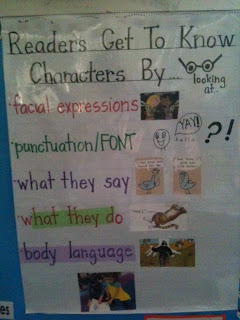Science Lab Report Writing for First Graders
Hello Teachers and Coaches! Can you believe it is May? It is time to experiment. For many of us, this means we will experiment with our teaching while we invite kids to create science experiments in our classrooms. Before I write any further I need to thank some teacher friends of mine who have helped me experiment with Science writing for first graders. Special thanks for this post go to the first grade team at PS 267, especially Breanne and Francessca who tried this writing unit for the first time last year. Much of what I learned about science lab report writing for first graders, I learned along side of them and the science teacher at their school, Mr. Sloane. And, I also need to thank the inspiring first grade team at Lake Mills Prospect Elementary school. The charts you see here were up in Hillary's classroom as we began this Science Writing Workshop unit last week together. Deb, Sherry, Nick, Stacy, Desha, and Amanda shared in the planning and teaching fun too. Cheers to these two amazing first grade teams and all of the amazing first grade teams out there!
Okay, now, on with the science writing fun! If you are reading through the amazing science writing unit of study from the Teachers College Reading and Writing Project and want some support to launch it, here are some of the things we tried at 267 and Prospect Elem.
First, we recognized that this science unit was all about creating experiements and writing them up like a real lab report. The teachers did observation journals for science writing earlier in the year with other topics like observing animals changing and growing over time. Now, it was time to actually experiment and so they decided to teach this writing unit along side of the science content of liquids, solids, and gases. Specifically, they wanted kids to investigate different liquids, mixing, combining, and asking questions about how things combine and perhaps become a solution.
In the classroom, Hillary read aloud a great book,
Then, she asked her kids to turn and talk about all the things they learned from this book and what they knew from previous experience about what scientists do. They made this great list:
The next day, we conducted a whole class experiment, much like we would do a whole class read aloud. I gathered the kids at the carpet and we had a bunch of liquids in front of us.
"What can we do with these?" I asked.
"Mix them up!!!" a first grader shouted.
So, we began to ask questions about which things we should mix, how we should mix them, how much we should mix, how long we should mix, and when we should observe. Each of these are variables and yes, we used that scientific word with the kids. The kids talked with their partners and then we came back together as a whole class to conduct the experiment and write the lab report. We asked the question, "What will happen when we add water and oil to a jar and then shake it up 20 times and then wait 20 seconds?" Here are the two charts that guided our experimenting and writing.
As we conducted each part of the experiment, I wrote the lab report for the kids and the paper was projected so they could see their words and the record of the experiment going onto the paper. You can use chart paper on the easel to do this or a document camera. Keep in mind that first graders CAN most definitely do this! Think of the whole-class experimenting and writing as a shared writing experience. They can ask a question and make a prediction. Let them turn and talk with partners and record the things they say on the lab report paper. They can write a list of materials needed and a procedure. It is just like a How-To Book! Remind them of this and then have them rehearse it out loud with their partners. And, you, the teacher, record it on the paper right there in front of them. Record the observations with drawings, labels, and sentences. Let them give you the words for this. They will see it happening so let them talk with partners and give you the words.
I hope to post a first grader's lab report up here soon. The kids in Hilary's class were ready to design their own mixing experiments that day! When we finished this experiment, every single first grader had new questions about mixing and combining. They all went off to their tables and wrote the first two pages of their own lab reports.
Let the experimenting begin! Have fun Teachers!







